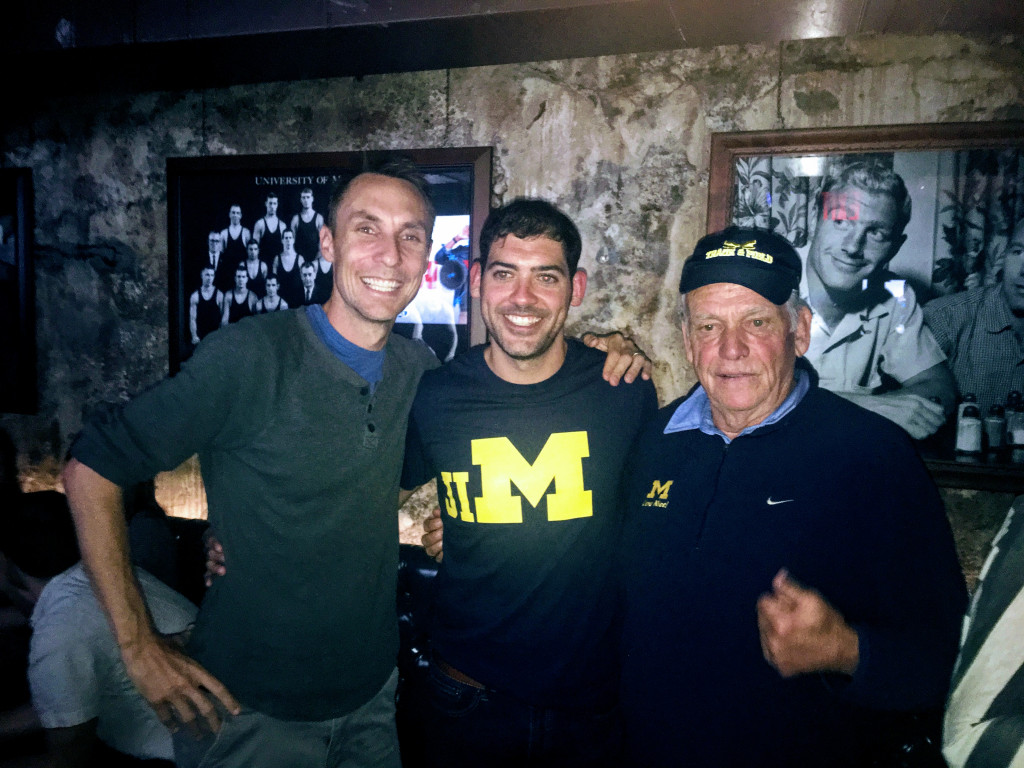Dear Distance Gurus: What Are Your 3 Favorite Mile Workouts?
LetsRun.com has launched a new coaching advice column. In column #2, John Kellogg and Robert Johnson share their favorite mile workouts.
By Robert JohnsonIn the year 2024, there are all sorts of advice columns all over the internet, but we’ve never seen one for distance running. That is now changing. Back when LetsRun.com started in 2000, John Kellogg‘s near-daily message board postings on training were a hallmark of LetsRun.com but he’s gone dark from the web for 20+ years. That’s changing now.
Hopefully each week, John and LetsRun.com co-founder Robert Johnson will be answering your questions in our “Dear Distance Gurus” column. John is most famous for transforming Weldon Johnson from a college hack with a 30:06 10,000 PR to a near-Olympian who ran 28:06 and finished 4th at USAs twice. Robert and John then used John’s training methods to win zero Ivy League XC titles totally dominate the Ivy League in indoor and outdoor track during a 10-year coaching stint at Cornell University where they captured 13 Ivy League track titles.
Now that the statute of limitations from their Cornell tenure is over as almost everyone they coached is retired, they will be handing out their advice on LRC. If you have a question for a future column, email it to DDG@letsrun.com.
In the first column (which was more than a month ago but we hope to do it weekly), they analyzed Hobbs Kessler‘s training. Rather than stay on that topic, they want to answer another more topically mile-related question this week.
Dear Distance Gurus (DDG):
A few weeks ago there was a discussion on the message board about the three best workouts for a miler – MB: Mark Coogan says that if you could only do 3 workouts as a 1,500m runner you should do these – after Mac Fleet asked New Balance coach Mark Coogan on the Citius podcast what workouts would he give a miler if he was only allowed to give out three.
Coogan responded:
*20-25 min threshold work +4-6 x 45 seconds at 1,500m pace
*6-7 x 1k at 5k pace
*12 x 400 at 1,500m pace w/90 seconds recovery – if needed split into 2 sets
What do you guys think of his reply? What 3 workouts would you prescribe?
-Dreaming of Sub-4
Rojo: I think the answers are a decent start. I mean obviously everyone in the world who knows what they are doing is going to likely to offer some combination of the following:
1) A threshold/tempo type of workout
2) Something aerobically more challenging than that
3) Something at mile pace or a little faster
When I gave this question to John Kellogg, he quite honestly didn’t want to answer it. He said something along the lines of, “Why would anyone in the world limit themselves to doing just the same three workouts? That’s beyond stupid, seeing as how you obviously CAN do more than just three workouts. And it could end up being a recipe for disaster as you are naturally going to be comparing yourself to the last time you did the workout and forcing things instead of just letting yourself run it faster naturally as you get fitter for that pace in the intervening weeks.”
It’s kind of funny as for this column today, John’s and my roles are kind of reversed from where they were at Cornell. One of the hardest things about coaching with John is he likes things done perfectly and kind of sometimes operates in a theoretical world.
Him: “Based on the weather, the guys need to do the workout at 12:30 tomorrow at 3,000 feet of altitude.”
Me: “That’s not going to happen, they have class and we live in Ithaca.”
Now that conversation never actually happened but hopefully you understand the sentiment. A big part of my job was putting what he viewed as being the best workout in theory into day-to-day reality and making it work with mercurial college students, given the weather and class requirements.
But here are the three workouts we’d give to milers. We’re sure everyone is going to be into reading #3 — our signature mile workout — but we’ll make you read the less sexy workouts first.
Workout #1 – Progression Run + Buildups
Go out for a normal hour run. After you are warmed up, gradually bring the pace down after 30 minutes. Spend maybe 30 minutes in the high-end zone, starting from the easier side of it and working down to the faster side.
Then after you’re done, take 3-4 minutes rest and maybe switch to spikes and then get on the track and do 6-8 x cut-down buildups. Start them slow and cut them down. So the last 2-3 are pretty fast. On the last one, you can blow your pipes out a little bit. This is about relaxation and speed maintenance, not tying up. You may feel kind of crappy on the first few. Very similar to the 200s we give at the end of workouts #2 and #3 but these shouldn’t be that long — maybe 15 seconds to 150 meters max.
Now what is high-end pace?
High-end pace is pretty much the fastest pace that you can run that still feels comfortable. There’s a little bit of aerobic pressure but you aren’t hyperventilating or getting tight or feeling the slightest hint of laboring. You should feel strong and full of run. I remember in high school finally finding that pace and thinking “Why don’t I run this pace every day?”
The pace range is roughly 1:40 slower to 0:50 slower than your mile PR. So a 4-minute miler would start off the high-end running around 5:40 pace (after going slower for the first half of the 1-hour run) but would spend most of the high-end portion at between 5:15 and 5:00 with a few minutes at 4:50 at the end. PLEASE NOTE, YOU NEED TO RUN IT BY FEEL AND NOT PACE. Start super slow and DO NOT get married to the stopwatch! Using a pace chart — even OUR pace chart (which is as accurate as it gets) — might have you going either too slow or too fast to get the training effect you want. Learn to find the right effort by letting the pace come to you.
If the pace DOESN’T come to you on a planned progression run, just jog easy the whole day, maybe do a few light strides at the end, and try the next day.
Please note if you only were allowed to do ONE workout and this was it, you could get pretty close to your mile PR as long as you also did a bunch of early season mile races as workouts, running them with a slight negative split (so you use the races as workouts to kind of cheat on the “only x number of workouts” rule). We imagine if you have a proper base and then race yourself into shape in this manner, you could get within 2 seconds of your potential mile PR without having to do the faster stuff shown in workouts #2 and #3.
Workout #2 – “Crest Load” Work + Speed Maintenance
John is a big fan of crest load work — it’s right around the pace you could run for an all-out, evenly-paced 40-minute race. It’s roughly 10-15 seconds per mile faster than your theoretical “lactate threshold” pace — so 10-ish seconds faster than the FASTEST “high-end range” pace listed in workout #1 (but more if you are a slower runner). For a 4-minute miler, John’s guideline chart has a crest load pace of 4:41 mile pace, but for a 5:00 minute miler, his chart has it at 5:56 (and 6:07 is at the fastest side of high-end pace for a 5-minute miler).
It’s the pace where you are going past your threshold and begin hyperventilating. You are just beginning to feel the anaerobic discomfort start to develop, but we shut the effort down before you get into distress. You’re using lactate as a fuel but aren’t going into acidosis yet. It’s important to jog between the work bouts at crest load effort since that keeps the heart rate up enough to make sure you’re training to re-uptake lactate (which is the main vehicle of improvement from crest load training).
Here’s the workout:
4 minutes on @ crest load pace / 3 minutes off (light jog), 8 minutes on @ crest load / 3 minutes off (light jog), 12 minutes on @crest load / four minutes off (light jog), & then 4 minutes on @crest load (a little faster at the end, squeeze it down). As with the progression run, you need to learn what crest load running FEELS like so you can pace yourself properly and hopefully get all the segments done at a pace that TRAINS you well but doesn’t HYPERTRAIN you.
After the last segment, jog for a couple of minutes and take some extra rest (3-5 minutes) while switching into spikes (so maybe 7 minutes total rest between end of crest load and start of speed maintenance work), then do a set of 6-8 x 200 cut-downs (or 150s if you do 200s in workout #3) with 1:00 to 1:30 rest (1:00 on the first few, more rest the faster you go) and then add a finisher rep on there, like 1 x 600 (at 3k/3,200 pace at the start of season, a little slower than mile pace at the end of year). You do not want to tie up on the 600. Run even or negative spits on this, so you feel some slight burn in the last 50 but don’t rig out.
For the 200s, start off slow at tempo pace (for an elite 4-minute miler it would be close to 40 seconds – yeah, that slow for starters) and then cut it down to close to 800m pace for the last 2-3 (maybe a little faster on the last one). Take 1:00-1:30 rest. This isn’t supposed to be tying-up speedwork. The point of speed maintenance isn’t to run HARD. It’s to touch on running FAST. You should start feeling smooth after the first couple of slower reps and just get faster as you go. RELAXATION is key and will make you faster.
You could do the speed maintenance stuff up and down a shallow hill to get a different recruitment pattern and ground contact time if you want to (no steeper than 3% on the downhills). This also lets you cheat a little on the “only 3 workouts” thing.
Workout #3 – Oxygen Uptake / Mile Pace Work
5 x 2 minutes on (around 700m for most competitive milers)/ 2 minutes off at somewhere CLOSE to mile pace but maybe not quite as fast as that. You need to start a little slower than mile pace (about 1 second per 400 slower than mile pace). After about 3, you are really going to be questioning if you can finish but see if you can squeeze it down to mile pace or slightly faster. It’s critical that EVERYTHING NEEDS TO BE SLOWER TO FASTER as that’s how you achieve the best rhythm and accumulate the optimum amount of time in your target pace zone (and slower to faster is how almost all championship mile races go). If you don’t quite get faster than mile pace by the 5th rep, that’s okay as you’ll do some speedwork shortly after the 5 x 2 min. Then do a 5-8 minute super-slow jog and tack on 6-8 x 200 cut-downs (same format and pace as in workout #2).
“This is oxygen uptake / race pace work and you get some hard anaerobic effort that trains your muscles to process lactate and fosters mental toughness, and it fortifies your bicarbonate buffering system,” said John. “It’s a real knee grabber, so don’t go to the well too often with it unless you’re naturally very talented in the middle distances and can recover quickly from these hard workouts.”
If we were coaching you, we obviously wouldn’t be limited to just three workouts. So the next week, we’d probably have you do the following workout which is similar to the one above (and similar to Coogan’s 12 x 400 with 90 seconds rest) – 8 x 400 at mile pace (starting slower) with 60 seconds rest. Now that’s pretty advanced. Younger runners or advanced runners early in the season might want to do it with 90 seconds rest or break it up into sets of 3, 3 and 2 x 400.
We’d recommend alternating those workouts every other week so at most every three weeks you are repeating the same workout.
“(5 x 2 minutes on /off) is better than doing the quarters as long as you add that speed maintenance after it because you’re maintaining the rhythm longer and working more on oxygen uptake, and with the faster 150s or 200s added at the end, you get to recruit those quick twitch fibers,” said John. In actuality, we didn’t do that 5 x 2 minutes workout that often at Cornell. The signature mile workout we used and one that is amazingly good at predicting how fast you’ll run in the mile is as follows…
The “Cornell” Mile Workout
Let’s call it the Cornell Mile Workout but we certainly didn’t invent the workout. John can’t remember where he heard it, but he remembers reading that the Soviet Union did it during the 1970s (remember Kazankina’s world records?) and that it might have originally come from Horwill’s “5-pace system.”
2 sets of (400 at mile pace, 45 seconds rest, 800 at mile pace, 90 seconds rest, 300 at mile pace). After the first set, take a 4.5 minutes walk/jog rest and repeat. Run the first set a little slower than goal mile pace the first time you try it. Whatever pace you average on this bad boy is almost exactly what you’ll run in the 1,500.
I can’t believe I just gave out one of our favorite workouts for free in our second column. Oh well. 😉 But that’s super-hard and kind of advanced and is more of a race simulator. We only did it three times a year (during indoors and outdoors combined).
Got a question? Email us DDG@letsrun.com.
Talk about your favorite mile workouts in our world-famous fan forum / messageboard.






